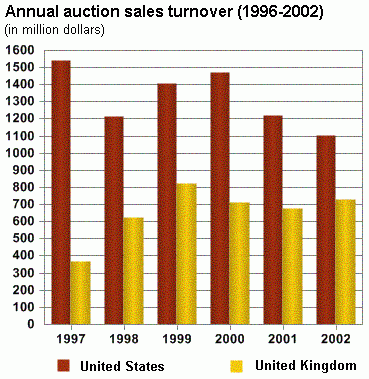New York/London: partners or rivals?
[10/03/2003]
Fine art sales fell by 13% in the USA in 2002, compared to just 7.3% globally, while sales in the UK market remained stable. The UK was the main beneficiary of the US decline and now has 27.5% of the world market against the USA’s 42%.
Behind this structural change lays a dramatic slump in the number of catalogued US sales, down by nearly half in three years to just 2,300 in 2002. The result has been a halving in lots sold since 2000, although, higher prices and better quality lots have gone some way towards cushioning the blow. In the UK lots sold were also down, but less drastically than in the USA, and turnover was unchanged. More worryingly, in the last two years the number of catalogued sales has fallen by 25%, from 3,410 to 2,576. True, this is small beer compared to the slump in the USA. Thanks to its native resources and a different economic climate, the British market held up better. But neither market is isolated from the other.

The UK is nibbling at the USA’s market share but, taken as a whole, the anglo-saxon bloc remains unshaken. Between them the US and UK still command 70% of the world art auction market. This is unlikely to change as the same two big auction houses dominate both sides of the Atlantic.
But swings in popularity between these two leaders are likely, particularly as both London and New York deal in nearly identical types of work. And big sales in both venues are invariably hosted by the same two auction houses. The proportion of high-priced lots and frequency of record prices are also uniform across both markets. But, breaking down the US market by price strata reveals a very different market to London. In New York, 21% of works went for between USD10,000 and USD100,000. In London, just 11.5%. London, like New York, hosts prestige sales of modern, impressionist and contemporary art, but tends to make more room for drawings and prints. Traditionally, the world’s big auctions, run to a schedule set by the big houses, take place in New York in May and November and in London in June/July and February.
Competing for the same turf, the two countries seem ever more interchangeable in the auction game. Not surprising, then, that the British are fighting hard to escape European economic and tax restrictions that might threaten their competitiveness.




 0
0
